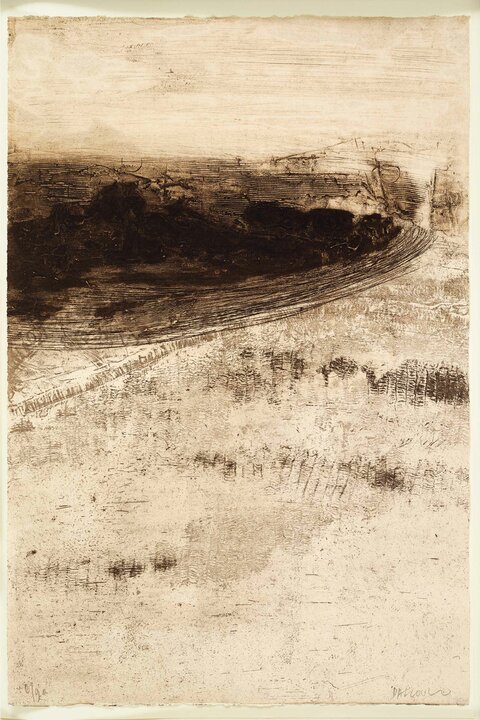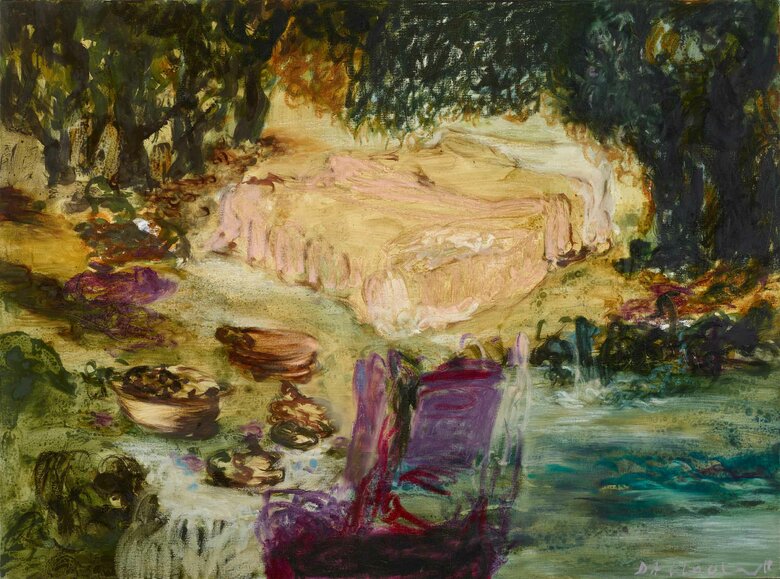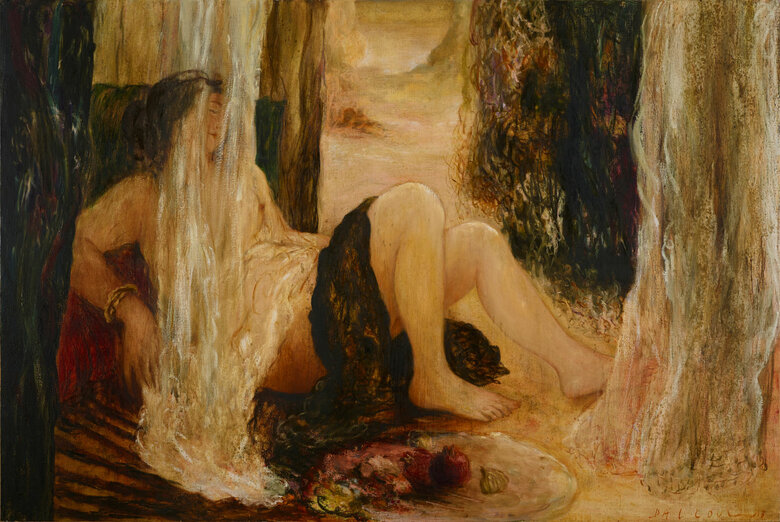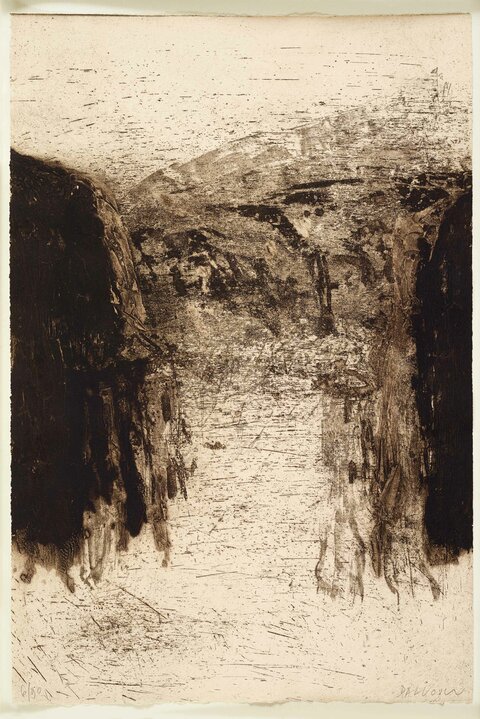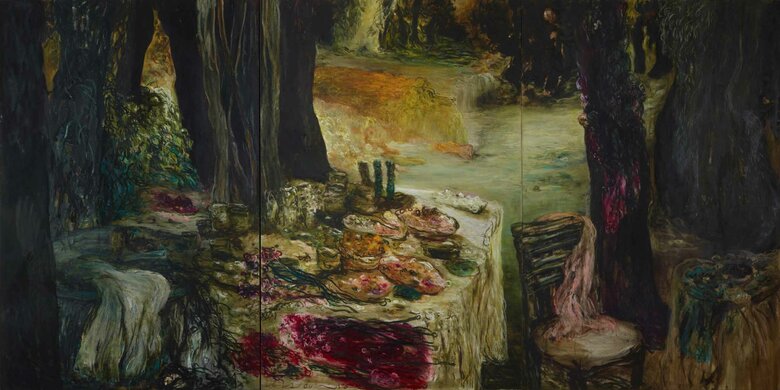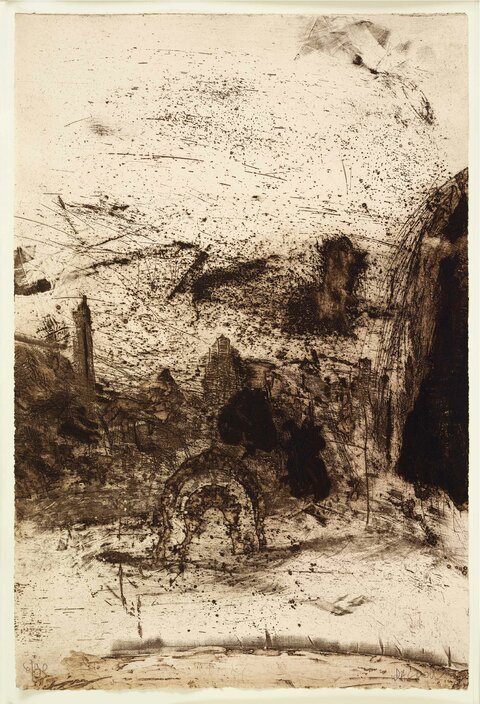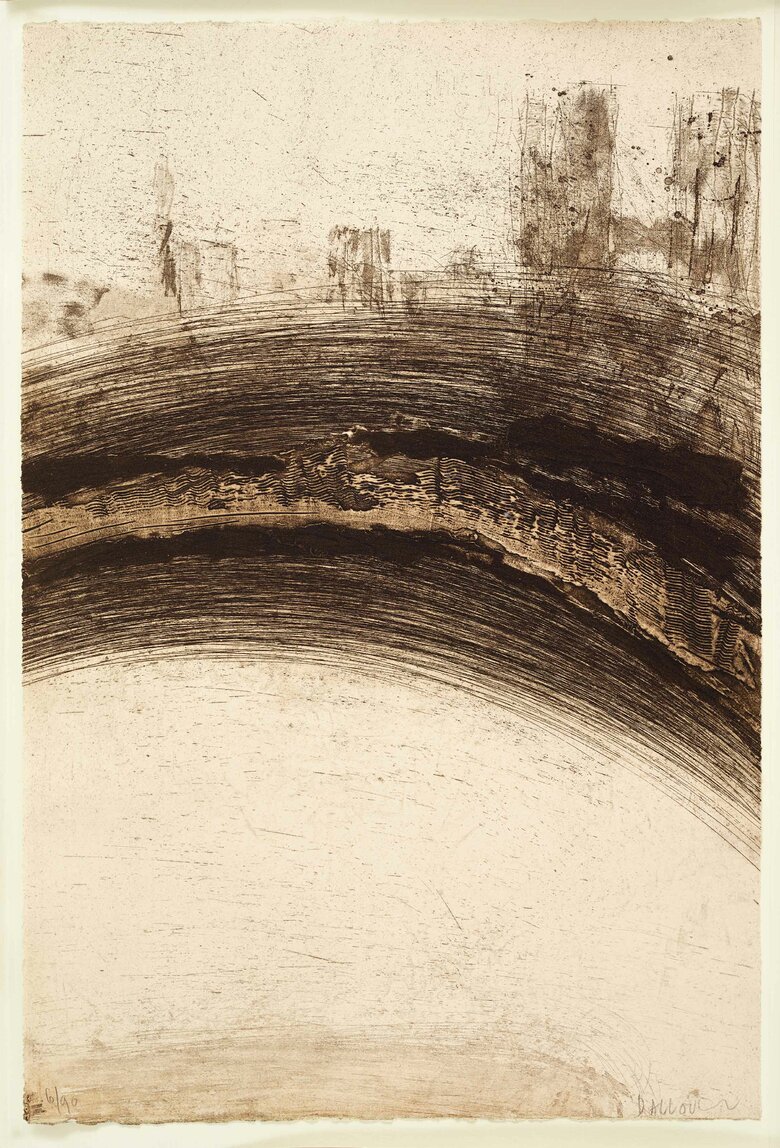Born in 1953 in Soueida, southern Syria, Ziad Dalloul began his creative path early on in his life. At the age of sixteen, Dalloul nurtured his cultural and artistic talents, engrossing himself in...

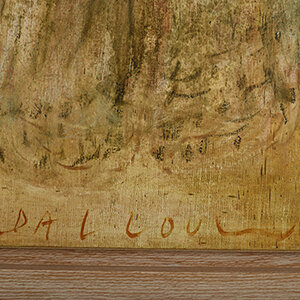
ZIAD DALLOUL, Syria (1953)
Bio
Written by Mysa Kafil-Hussain
Born in 1953 in Soueida, southern Syria, Ziad Dalloul began his creative path early on in his life. At the age of sixteen, Dalloul nurtured his cultural and artistic talents, engrossing himself in art and writing, and exhibiting his first paintings and reciting his own short stories in his hometown’s cultural center.[2] Since then, his career has flourished and he is now considered to be among the Arab world’s most accomplished printmakers and painters, and a pioneer of contemporary Syrian art, merging multiple media techniques.
"Painting a landscape on one's canvas is not an end-in-itself… You have to step into the landscape to see it from the inside, deconstruct it in order to reconstruct it in accordance with our fantasies and memory which is inseparable from the representation of any work of art.”[1]
Ziad Dalloul
In the early 1970s, Dalloul moved to Damascus and soon enrolled in the city’s Faculty of Fine Arts, graduating in 1977, where he was trained under the prominent artist Ghayyath al-Akhras, founder of the engraving department. That same year, he held his first solo exhibition in the Syrian capital, in the popular Urnina Gallery.[3] The 1980s saw Dalloul move to pastures new: initially he moved to Algeria in 1980, where he developed the visual arts program for the Algerian Ministry of Education, and then in 1984 he moved to Paris. In Paris, he enrolled into l’École Nationale Supérieure des Arts Décoratifs, where he completed a DEA (advanced post-gradute degree), in Plastic Arts, graduating in the late 1980s. From this point onwards, he remained in Paris and adopted it as his new home, however, memories of Syria remained in his heart and in much of his work.
The 1990s saw Dalloul focus primarily on his printmaking, winning the Gold Medal at the International Printing Triennial in 1994,[4] and the Gold Medal in the First Cairo Biennale for Graphics in 1997. Using handmade paper with black and sepia ink, Dalloul created a large number of intricate and abstract etchings during this period, many of which can be found in the Ramzi & Saeda Dalloul Art Foundation Collection, including the following: Tombeau pour New York, Douze Lanternes pour Grenades, La Main de la Pierre Dessine le lieu, Marrakesh/Fes l’Espace Tisse l’Interpretation, Cheminement du Désir dans la Géographie de la Matiere, Le Temps, Le Corps du Soleil, Au Sein d’un Alphabet Second, and Berceau, all produced in 1999. Using his own unique techniques when engraving his plates, he creates monochromatic images which appear akin to a painted canvas, complete with rhythmic and intentional brushstrokes producing mysterious scenes with hints of a landscape in the distance, especially visible in Le Corps du Soleil and Au Sein d'un Alphabet Second. Some works appear less obscured, although equally abstract, for example Berceau and Tombeau pour New York, both of which have aspects of linear, structured physical entities, forming a clearer vision into the scene in Dalloul’s imagination.
In 1999, he also produced a series of etchings entitled The Book of Cities (Le Livre des Villes), which formed an artist book in collaboration with Syrian poet, Adonis, one of which can be found in the Dalloul Collection. Using somewhat muted watercolours and ink, he created spontaneous, visual interpretations of Adonis’ poems, which he wrote in tribute to cities around the world. [5] As a writer himself, there has always been an underlying link between his artwork and poetry, an artform he appreciates and understands thoroughly, and in turn, his artworks can be interpreted as a form of visual poetic expression. When looking at Dalloul’s work, Adonis himself could see the depth within, commenting, “In color and through color, Ziad Dalloul travels towards objects and within them. He moves among its gradations and layers, exploring its mysteries. His colors do not merely question nature but also carry a preoccupation with research…”[6] Together, Dalloul and Adonis have collaborated on several books.[7]
In the 2000s, Dalloul began to work predominantly with oil on canvas. Employing an earthen, dark palette, he painted compositions developed through his imagination, whilst perhaps incorporating elements of childhood memories from Syria. Whilst his romantic canvases may have taken a distinct turn from his stark etchings of the 1990s, Dalloul is proud of the classical undertones in his work, believing that “to create contemporary art, you need to first understand the history of art…I make sure that my work respects the history of modern painting. But my palette, concepts, techniques and art practice are contemporary.”[8] Many of his paintings of this nature can be found in the Dalloul Collection, including Venus (2010), Nocturnal Visit (2012), The Autumn Feast (2012), Bed in the Waterfront (2012), Evocation (2013), Waterfall (2013), Les Baigneuses (2013), Trunk (2013), Torrent of Memory (2013), Suzanna and Elders (2013), Celebration of the Absent (2013) and Danaé (2013). In much of the paintings, Dalloul fuses everyday domestic scenes with ethereal landscapes, flowing water and mystical female figures, with the intention of making the viewer consider our distance from the environment by juxtaposing human life and nature together in one composition.[9] Elements intentionally blend together, for example table cloths, drapery and clothing appear almost as waterfalls in Danaé, Torrent of Memory and Les Baigneuses, whilst the opposite occurs in Waterfall, creating a constant merging of interior and exterior. This theme continues in the confluence of intimate spaces (for example the bed) and open, raw environments, as seen in Nocturnal Visit, Bed in the Waterfront, and La Chambre, forming an atmosphere of intimacy, vulnerability and abandonment.[10]
Dalloul has a unique, personal approach to still life compositions, rejecting the French terminology ‘nature morte’ (still life, or literally ‘dead nature’), preferring the phrase ‘nature silencieuse’ (‘silent nature’), closer to the Arabic translation of the expression (al-ṭabīʿa al-ṣamita).[11] In Celebration of the Absent, for example, Dalloul tries to create a warm, lived-in feeling, laden with copious amounts of flowers, fruits and various dishes to form a silent celebratory banquet amongst nature for people who cannot be seen, or may not even exist in this mysterious world.[12] In all of his paintings, Dalloul’s sensitive use of light brings us further into his composition, delicately hitting the water, a woman’s hair, or the folds of the luxurious fabrics, giving us slight hints of life, emotion and magic hidden within the enchanted landscape.
Dalloul has exhibited his work across Europe and the Middle East, with a significant number of solo exhibitions in prominent galleries. He continues to live and work from Paris.
[1] Darat Al Funun, “Ziad Dalloul”, Darat Al Funun: The Khalid Shoman Foundation, n.d., https://daratalfunun.org/?artist=ziad-dalloul
[2] Athr Gallery, “Ziad Dalloul”, Athr Gallery, Jeddah, n.d., https://www.athrart.com/artist/Ziad_Dalloul/biography
[3] Ibid
[4] Nabad Art Gallery, “Ziad Dalloul”, Nabad Art Gallery, Amman, n.d., https://www.nabadartgallery.com/?q=node/68
[5] Jyoti Kalsi, “Tearing Down Walls”, Gulf News, December 9, 2011, https://gulfnews.com/entertainment/arts-culture/tearing-down-walls-1.944716
[6] Nabad Art Gallery, “Ziad Dalloul”
[7] Mohammed Omran, “زياد دلول.. في الثناء على ما تبقّى”, Alaraby, March 2, 2015, www.alaraby.co.uk/زياد-دلول-في-الثناء-على-ما-تبقّى
[8] Kalsi, “Tearing Down Walls”
[9] Kalsi, “Tearing Down Walls”
[10] Omran, “زياد دلول.. في الثناء على ما تبقّى”
[11] Darat Al Funun, “Ziad Dalloul”
[12] Kalsi, “Tearing Down Walls”
Sources
Athr Gallery: “Ziad Dalloul”. Athr Gallery, Jeddah. Accessed September 2020. https://www.athrart.com/artist/Ziad_Dalloul/biography
Darat Al Funun: “Ziad Dalloul”. Darat Al Funun: The Khalid Shoman Foundation. Accessed September 2020. https://daratalfunun.org/?artist=ziad-dalloul
Kalsi, Jyoti. “Tearing Down Walls”. Gulf News. December 9, 2011. Accessed September 2020. https://gulfnews.com/entertainment/arts-culture/tearing-down-walls-1.944716
Nabad Art Gallery: “Ziad Dalloul”. Nabad Art Gallery, Amman. Accessed September 2020. https://www.nabadartgallery.com/?q=node/68
Omran, Mohammed. “زياد دلول.. في الثناء على ما تبقّى”. Alaraby. March 2, 2015. Accessed September 2020. www.alaraby.co.uk/زياد-دلول-في-الثناء-على-ما-تبقّى
CV
Selected Solo Exhibitions
2023
Ziad Dalloul: Shimmer of Memory, Kwai Fung Hin Art Gallery, Central, Hong Kong, Hong Kong
2015
Galerie Claude Bernard, Paris, France
2012
Athr Gallery, Jeddah, Saudi Arabia
Focus: Ziad Dalloul, Art Paris 2012 (with Galerie Claude Bernard), Grand Palais, Paris, France
2011
Green Art Gallery, Dubai, United Arab Emirates
2008
Paintings 2001-2008, Galerie Claude Bernard, Paris, France
2007
Focus: Ziad Dalloul, Art Paris – Abu Dhabi 2007 (with Galerie Claude Bernard), Grand Palais, Paris, France
2006
French Cultural Centre, Damascus, Syria
Ziad Dalloul: Paintings, Centre Jacques-Brel, Thionville, France
Ziad Dalloul: Prints, Art Space Conservatory of Music, Thionville, France
Riwaq Gallery, Manama, Bahrain
2005
Paintings, Prints & Artist Books, Musée de l’Institut du Monde Arabe, Paris, France
2002
Paintings-Prints, Palazzo della Cuba, Palermo, Italy
1997
Ziad Dalloul: Graphic Art and Painting on Paper, Darat Al Funun, Amman, Jordan
1996
French Cultural Centre, Damascus, Syria
Atassi Gallery, Damascus, Syria
1994
International Triennale of Graphic Arts of Cairo, Cairo, Egypt
1993
Works on Paper, 50x70 Gallery, Beirut, Lebanon
Queyras Gallery, Paris, France
1991
La Teinturie Gallery, Paris, France
1989
Works on Paper, Urnina Gallery, Damascus, Syria
Jean Attali Gallery, Paris, France
1988
Circumstances of the Places, Galerie La Nouvelle Gravure, Paris, France
Michael Vokaer Gallery, Brussels, Belgium
1987
International City of Arts, Paris, France
1985
Al-Rafah Gallery, Damascus, Syria
1980
Works on Paper, Galerie Racim, Algiers, Algeria
Ziad Dalloul: Paintings, Al Chab Gallery, Damascus, Syria
1977
Urnina Gallery, Damascus, Syria
1976
Cultural Centre, Soueida, Syria
Selected Group Exhibitions
2024
Eternity In Transience, Kwai Fung Hin Art Gallery, Central, Hong Kong, Hong Kong
From Landscape to Landscape, Kwai Fung Hin Art Gallery, Central, Hong Kong, Hong Kong
2023
Worlds Beyond Reality: Monet's Legacy, Kwai Fung Hin Art Gallery, Central, Hong Kong, Hong Kong
2021
Cities Under Quarantine: The Mailbox Project, Villa Romana, Florence, Italy
2019
Three Artists – Three Generations: Bady Dalloul, Ziad Dalloul, Maha Maamoun, Darat Al Funun, Amman, Jordan
2015
aide-mémoire: footnotes, Barjeel Art Foundation, Sharjah, United Arab Emirates
Des Parcours Syriens, Institut du Monde Arabe, Paris, France
2014
aide-mémoire, Barjeel Art Foundation, Sharjah, United Arab Emirates
2013
Exposition éphémère d'art contemporain, Institut du Monde Arabe, Paris, France
2012
The Power of Words: Artists from the Khalid Shoman Collection, Darat Al Funun, Amman, Jordan
2011
Sharjah Biennal 10, Sharjah, United Arab Emirates
2007
Art Inspired by Poetry: Artists from the Khalid Shoman Collection, Darat Al Funun, Amman, Jordan
2005
Ziad Dalloul – Farid Belkahia: The Continental Drift, Institut du Monde Arabe, Paris, France
2003
The Khalid Shoman Collection, Darat Al Funun, Amman, Jordan
2000
Journey Through the Contemporary Arts of the Arab World – Bilad al Sham (2): Palestine, Lebanon and Syria, Darat Al Funun, Amman, Jordan
1997
First Cairo Biennale for Graphics, Cairo, Egypt
Musée de L’Ephébe, Cap d’Agde, France
1993
French Cultural Centre, Rabat, Morocco
Sharjah Biennale, Sharjah, United Arab Emirates
1992
Mairie de la Courneuve, France
1989
SAGA, Grand Palais, Paris, France
South of the World, Marsalla, Italy
L’Atelier Gallery, Rabat, Morocco
1988
Chelsea Old Town Hall, London, United Kingdom
SAGA, Grand Palais, Paris, France
1986
XVII International Festival of Painting, Cagnes-sur-Mer, France
Le Salon Comparaisons, Grand Palais, Paris, France
Salon de Réalités Nouvelles, Grand Palais, Paris, France
Galerie Faris, Paris, France
1985
Salon de Mai, Grand Palais, Paris, France
International Miniprint, Cadaques, Spain
1980
Intergrafik, Berlin, Germany
1979
The Sixth Arabian Artist Biennale Exhibition, Kuwait City, Kuwait
Prizes
1997
Gold Medal, First Cairo Biennale for Graphics, Cairo, Egypt
1994
Gold Medal, International Triennale of Graphic Arts of Cairo, Cairo, Egypt
Collections
Atassi Foundation, Dubai, United Arab Emirates
Barjeel Art Foundation, Sharjah, United Arab Emirates
British Museum, London, United Kingdom
Fondazione Orestiadi, Italy
Institut du Monde Arabe, Paris, France
Jordan National Gallery of Fine Arts, Amman, Jordan
The Khalid Shoman Collection, Amman, Jordan
Al Mansouria Foundation, Jeddah, Saudi Arabia
Ministry of Culture, Damascus, Syria
Museo de la Solidaridad Salvador Allende, Santiago, Chile
Press
صحيفة الاتحاد - زياد-دلول--معالجة-الطبيعة-الصامته-بدلالات-خاصة.pdf
أدونيس وزياد دلّول_ الشعر والرسم في كتاب المدن _ - جريدة الحياة.pdf
L_art du livre arabe.pdf.pdf
أدونيس شاعراً وزياد دلول رساماً في كتاب المدن. مدن شعرية بين الجغرافيا والوهم تضيء التاريخ بحثاً عن مثال مفقود _ - جريدة الحياة.pdf
عن معرض زياد دلول في الثقافي الفرنسي.pdf
Al-Ahram Weekly Books Poetisation of the metropolis.pdf
زياد دلول يعرض أعماله الجديدة في دمشق,.pdf
جريدة الأخبار.pdf
زياد دلول.. احتفاء بالبَصَر والبصيرة - البيان.pdf
ZiadDalloul_Celebrations of the Absent_GreenArtGallery_Press.pdf
Ziad Dalloul - Darat al FununDarat al Funun.pdf
ZiadDalloul_Tearing down walls_GulfNews.com_Press.pdf
زياد دلول.. معالجة الطبيعة الصامته بدلالات خاصة - جريدة الاتحاد.pdf
عن معرض زياد دلول في الثقافي الفرنسي الجمل بما حمل نضع أخبار العالم بين يديك ونأتيك بـ الجمل بما حمل قبل أن لى aljaml.com.pdf
زياد دلول يعرض أعماله الجديدة في دمشق.pdf
زياد دلّول يتقدّم في خرائط المادة.pdf
Ziad Dalloul, « La table est dressée » _ par Martine Monteau.pdf
اللوحــــــة التـــــــــي تأتـــــــــــــي كحقيبــــــــــــة ســــــفر .. زياد دلول.. ولغز الأسود الخلاسي والأصفر المؤتلق.pdf
الحياة - الرسام السوري زياد دلول في الملاذ الجمالي الآمن.pdf
جريدة الرياض زياد دلول يفتتح معرضه الشخصي الأول في جدة.pdf
طباعة - زياد دلول.. في الثناء على ما تبقّى.pdf
Ziad Dalloul de la peinture à la gravure. - Aux tours des flots troubles.pdf
لوحات زياد دلول تكوينات على حدود المرئي والمتخيل.pdf
موقع السويداء اليوم - الفنان زياد دلول رسام الفردوس المستعار.pdf
Syrian Artist Ziad Dalloul and his wife artist Layla visit to Ibrahimi collection on 7 Oct. 2019 _ Ibrahimi Collection.pdf
ZIAD DALLOUL Artwork
Become a Member
Join us in our endless discovery of modern and contemporary Arab art
Become a Member
Get updates from DAF
Follow Artists
Save your favourite Artworks
Share your perspectives on Artworks
Be part of our community
It's Free!
We value your privacy
TermsCookiesPrivacy Policies
Become a Member
Get updates from DAF
Follow Artists
Save your favourite Artworks
Share your perspectives on Artworks
Be part of our community
It's Free!
We value your privacy
TermsCookiesPrivacy Policies
Become a Member
Get updates from DAF
Follow Artists
Save your favourite Artworks
Share your perspectives on Artworks
Be part of our community
It's Free!
We value your privacy
TermsCookiesPrivacy Policies
Welcome to the Dalloul Art Foundation
Thank you for joining our community
If you have entered your email to become a member of the Dalloul Art Foundation, please click the button below to confirm your email and agree to our Terms, Cookie & Privacy policies.
We value your privacy, see how
Become a Member
Get updates from DAF
Follow Artists
Save your favourite Artworks
Share your perspectives on Artworks
Be part of our community
It's Free!
We value your privacy
TermsCookiesPrivacy Policies


